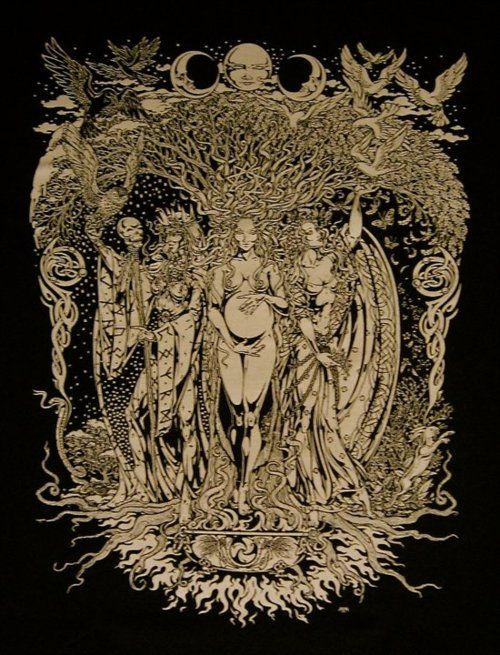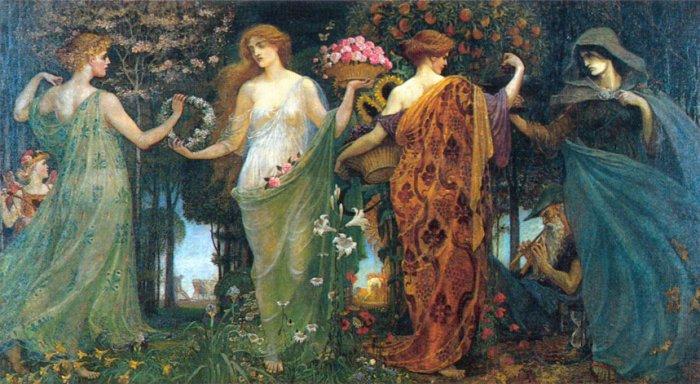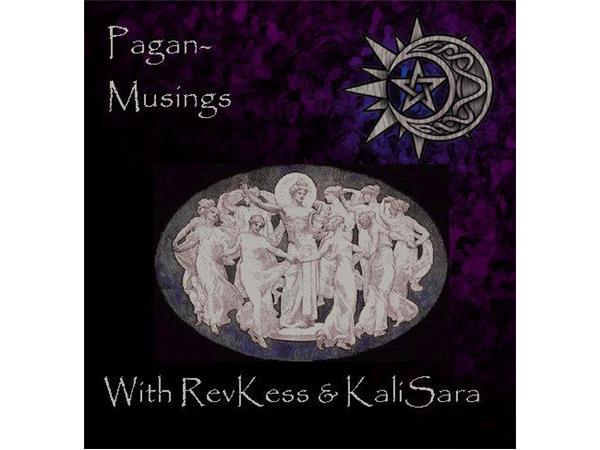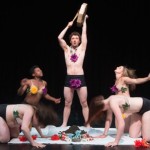 1. Gerald Gardner did not worship the Triple Goddess. Gerald Gardner, the father of Wicca, did not mention a Triple Goddess in his “Book of Shadows”. Nor does Gardner mention a Triple Goddess in Witchcraft Today, which was published in 1954. He does mention a Triple Goddess in his book, The Meaning of Witchcraft, published in 1959, but only briefly. Similarly, Raymond Buckland, who is credited with bringing Gardnerian witchcraft to America does not mention the Triple Goddess in Witchcraft from the Inside (1971) or his book, Tree: The Complete Book of Saxon Witchcraft (1974). The Triple Goddess is mentioned only briefly in his best-selling Buckland’s Complete Book of Witchcraft (1986), published twelve years later, and with no exposition.
1. Gerald Gardner did not worship the Triple Goddess. Gerald Gardner, the father of Wicca, did not mention a Triple Goddess in his “Book of Shadows”. Nor does Gardner mention a Triple Goddess in Witchcraft Today, which was published in 1954. He does mention a Triple Goddess in his book, The Meaning of Witchcraft, published in 1959, but only briefly. Similarly, Raymond Buckland, who is credited with bringing Gardnerian witchcraft to America does not mention the Triple Goddess in Witchcraft from the Inside (1971) or his book, Tree: The Complete Book of Saxon Witchcraft (1974). The Triple Goddess is mentioned only briefly in his best-selling Buckland’s Complete Book of Witchcraft (1986), published twelve years later, and with no exposition.
2. Gerald Gardner visited Robert Graves. In 1961, Idries Shah brought Gardner to visit Graves at his home on the island of Majorca. (Fred Adams, the founder of Feraferia, also visited Graves in 1959.) Gardner did write an essay about the Triple Goddess entitled “The Triad of the Goddess”. (I am grateful to Morgan Davis of geraldgardner.com for drawing my attention to this essay. I’ll be glad to email a .pdf of the document to anyone who requests or you can download it here.) The essay was found among Gardner’s papers which were purchased by Ripley’s from Gardner’s Witchcraft Museum. Unfortunately, the essay is undated. (I have seen someone else give it a date of 1958, but in any case, it appears to have been written after Gardner read Graves.) In the essay, Gardner describes the “triad of the Goddess” as “LOVE:DEATH:REBIRTH” and compares it to the Christian Trinity and to the triad of “Vrahmin, Vishnu and Siva”. Gardner argues that the death aspect is misinterpreted as a “Hag aspect” (here he seems to be responding to Graves), and that the true death aspect is not frightening, but comforting. This is consistent with Gardner’s conception of the Goddess as “light” and the God as “dark”.
3. Robert Graves wrote about the Triple Goddess before he wrote The White Goddess. Many Pagans will know that Robert Graves described the Triple Goddess in his book The White Goddess, published in 1948. But four years earlier, in Hercules, My Shipmate, or The Golden Fleece, which describes the ascendancy of the Olympian gods over the Triple Goddess, he described the Goddess as Maiden, Nymph and Mother, corresponding to the New Moon, Full Moon, and Old Moon. Then, in 1946, Graves published King Jesus, where he described a Great Triple Moon Goddess of birth, love, and death. In the narrative, the Triple Goddess takes the form of Miriam (Jesus’ mother), Mary of Cleopas (Jesus’ potential wife), and Mary Magdalene (a witch who is a disciple of the old goddess religion).
4. The Triple Goddess was not always Maiden-Mother-Crone. Many Pagans know that Robert Graves more or less invented the Triple Goddess as Maiden-Mother-Crone. What you may not know is that Graves described the Triple Goddess in other ways, including Mother-Bride-Layer-out and Maiden-Nymph-Hag. Graves was primarily concerned with the Mother-Bride-Layer-out trinity, which describes the experience of the Triple Goddess from the male perspective of her son-lover-victim. The adoption of Maiden-Mother-Crone as the Triple Goddess’ principal formulation can probably be credited to Starhawk’s Spiral Dance and Margot Adler’s Drawning Down the Moon, both published in 1979.
5. The Triple Goddess herself was not the focus of Robert Graves’ book, The White Goddess. The White Goddess is about a lot of other things, like the Celtic Tree Alphabet, but even when he was writing about the Triple Goddess, Graves was less concerned with the Goddess, per se, than with the relationship between the Goddess and her male counterpart. For each aspect of the Goddess, there is a corresponding aspect of the man or the god who is her son (Mother), lover/consort (Nymph/Bride), victim (Crone/Layer-out), as well as poet (Maiden-Muse). As Mother, the Goddess gives birth to the god of the year. As Bride, the goddess takes the god as her lover, and in her womb he sows the seeds of his own rebirth. As Layer-out, the goddess inspires the god’s twin-rival to slay him, his death becoming a sacrifice to the goddess, a sacrifice which fertilizes the earth and makes possible his subsequent rebirth.
6. Robert Graves was focused on two aspects of the Triple Goddess (and neither of them were Maiden, Mother, or Crone). The focus of Robert Graves’ treatment of the Triple Goddess in The White Goddess is on her role as the lover and slayer of her consort. The tragic relationship to the Goddess as Lover-Slayer can be traced to James Frazer’s treatment of the goddess Ishtar and queen Semiramis in the second and third editions of The Golden Bough (but not in the 1922 popular abridged version). There are also precedents to be found in the Celtic legend of the Goddess of Sovereignty, the Hindu goddess Kali, and the Romantic motif of La Belle Dame Sans Merci in Keats and the pre-Raphaelite painters. Dion Fortune also wrote about this tragic relationship in The Sea Priestess. Although it was (self-)published six years before Graves’ The White Goddess, Graves may have been unaware of it.
7. Robert Graves described a Quintuple Goddess, too. Robert Graves’ conception of the Triple Goddess was constantly evolving. Never one to be held back by logical consistency, Graves combined the various aspects of the Triple Goddess into a Quintuple Goddess. He describes the five stations of her year: Birth, Initiation, Consummation, Repose and Death, and states that she must be worshiped “in her ancient quintuple person”. The five aspects of the Quintuple Goddess are, according to Graves: Mother-Maiden-Bride-Crone-Slayer. Starhawk picked this idea up in The Spiral Dance, where she describes the Goddess as a “pentad, the fivefold star of birth, initiation, ripening, reflection, and death.”
8. Robert Graves prophesied the revival of worship of the Triple/Quintuple Goddess. In the last chapter of The White Goddess, Graves prophesied that the worship of the Goddess would return. In a 1969 interview, he observed that a “curious result” of the publication of The White Goddess was that “various White Goddess religions started in New York State and California. I’m today’s hero of the love-and-flowers cult out in the Screwy State, so they tell me” — apparently alluding to the West Coast Neo-Pagan Revival. This may not have been self-aggrandizement, as Elizabeth Gould-Davis, the feminist author of The First Sex, wrote to Graves in 1973 and told him: “I suppose you know that you are the God of the new Movement here, the newest of the new women’s movements, and you are the only male creature who is admitted to godhead in the movement. It has all sorts of names because it is not yet co-ordinated. Small groups from California to New York have formed to defy Christianity and all organized religion, to worship the female principle, and to bring back the Great Goddess.”
9. Aleister Crowley wrote about the Triple Moon Goddess. In his 1929 book, Moonchild, Crowley identified the Triple Goddess as Artemis-Diana-Isis (Maiden), Persephone (Lover), and Hecate (Crone). He associated her with the full moon and heaven (Diana), the new moon and hell (Hecate), and the half moon, a state between heaven and hell (Persephone).
10. Jane Ellen Harrison inspired Robert Graves’ Triple Goddess. Robert Graves was undoubtedly influenced by the “Cambridge Ritualist”, Jane Ellen Harrison, who had also written about pre-Olympian matriarchial religion. Harrison also described the Goddess as Maid and Mother (Kore and Demeter), and united them in one being, comparing them to the Father and Son of the Christian Trinity, but she not identify a “dark” aspect of the Goddess or otherwise take the next step in the analogy with the Christian Trinity.
11. Freud wrote about the Triple Goddess. Before Robert Graves, Sigmund Freud wrote about a Triple Goddess of birth, love, and death, whom he related to the Fates, the Seasons, the tri-form Artemis-Hecate, and Mother Earth who receives the dead. You can read his 1913 essay, “The Theme of the Three Caskets” here. (The Triple Goddess comes up near the end the essay.)
12. One of Carl Jung’s disciples wrote about a Quadruple Goddess. Carl Jung’s follower, Eric Neumann identified four aspects of the Goddess, which he superimposed on a quartered circle (according to Jung, the universal symbol of wholeness and God-Self), which is incidentally the shape of the sacred ritual space created by many Neo-Pagans. The aspects of Neumann’s Goddess were: the Good Mother (concerned with vegetation and birth, and represented by Demeter, Isis, and Mary), the Virgin-Muse (concerned with inspiration and vision, and represented by Mary and Sophia), the Terrible Mother-Old Witch (concerned with death and devouring, and represented by Kali and Hecate), and the Young Witch (concerned with drunkenness and madness, and represented by Astarte, Lilith, and Circe). I would stress here that, like Graves’ Goddess, Neumann’s Goddess is described from a distinctly male-centric perspective.
13. The Triple Goddess did exist in antiquity. There are ancient Greco-Roman antecedents of the Triple Goddess, most notably in the writing of the Neo-Platonist Porphyry and the Roman commentator Servius. You can read more about this in my last post: “Will the Real Triple Goddess Please Stand Up?”
So there you have it. More than you ever wanted to know about the history of the Neo-Pagan Triple Goddess.
















